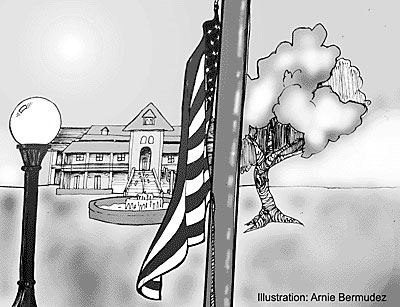
Illustration by Arnie Bermudez
|
|
By Jessica Lee
Arizona Daily Wildcat
Tuesday November 4, 2003
Homecoming is not all about the football game and riding on floats drunk in the parade. Rather, it is about celebrating the sense of connection each of us has to the University of Arizona. For at least four years, students will claim this patch of urban desert as our home. What is it about this place that will make us want to return each November to reminisce?
Is it the people? The events? The classes and assignments? The buildings?
In the spirit of celebrating the university, this column will briefly look back on how the UA used to be. Many of the details were taken from "A Photographic History of the University of Arizona: 1885-1985" by Phyllis Ball. Since volumes could be written on UA history, the remainder of this piece will take you back through time from a place we have all sat before: the west steps of Old Main. Let's pretend you have sat on the steps throughout the last century. This is what you would have witnessed:
It was back on Oct. 27, 1887, when the barren desert ground was broken for the construction of the first building of the new university for the Territory of Arizona. "Old Main," as it would be nicknamed in 1927, was built from gray stonework from the quarry south of Ajo Road and lumber delivered by train from San Diego. It would have been impossible to sit on the front steps of the building until after 1891, because they hadn't been installed yet.
The flagpole in front of you has nearly been in the same place for over a century. First pictured in an 1898 photo, the flagpole was often in the backdrop of pictures of UA cadets. The cactus garden was then planted in a large heart-shaped area in front of Old Main in 1896 and at one time contained more than 600 species. Off in the distance, there are hardly any buildings accept the prominent Tucson Indian Training School (one of the first schools we competed against in sporting events).
 |
|
Jessica Lee
Associate Editor
|
|
|
In 1905, the entrance to the university was upgraded from a makeshift fence that had no aesthetic value and only kept the cows out to a "dignified gateway of timber, brick and cement, flanked by stone walls. "
One of the most unusual campus structures was first located inside the main gate. The "flying cage" was funded from an unknown 1918 gift to build a "mammoth aviary" on campus to hold many local species of birds. After a year, it housed an American golden eagle, owls, hawks, doves and various parrots.
Shooting water into the air, the Memorial Fountain looks exactly like it did the day it was dedicated. On Jan. 31, 1920, Gen. John J. Pershing arrived to give a speech to honor the UA students who lost their lives in World War I.
By the 1920s, businesses began moving toward the university, locating at the corner of North Park Avenue and East Third Street (East University Boulevard). The businesses included a bakery, cleaner, shoe repair, post office, meat market, barber and beauty shop and the beloved corner drug store (which went out of business not too long ago). Until 1926, you would have been sitting in the dark on the Old Main steps. It wasn't until then that the main streets of campus were paved and "ornamental street lighting" was installed.
As years pass, the steps you sit on slowly become worn down. In 1938, Old Main was declared unsafe and it was locked up. It may have been torn down if the U.S. Navy hadn't stepped up in 1942 and put $89,000 worth of renovations into the building so it could be used as a wartime Naval Indoctrination School during World War II.
The building had various uses such as accommodations for the school bookstore, "rec hall" and offices of various student organizations until the Student Union Memorial Building was finished in 1951. By 1953, ROTC had moved into most of the building. One person complained at the time that Old Main was so ugly that "even a parking lot would be more attractive."
It wasn't until April 1972 when Old Main was recognized as a historical building by the National Register of Historical Places. The second floor was undergoing another renovation for the new offices for the Dean of Students.
A 15-foot, red "100" sign was put up in front of Old Main in 1985 as part of the university's centennial anniversary. Founders' Day, March 12 of that year, was held to celebrate the occasion with a parade, "historical skit," music and a huge cake shaped like Old Main.
Now, 18 years later, students still find the west side of Old Main as a refuge from the hustle and bustle of the UA. I urge you all to take time to appreciate the history of the UA from the steps of Old Main. Check out the Pride of Arizona Marching Band and the results of the Homecoming king and queen contest this Friday night at the bonfire, which will take place on these same steps.
Being a UA student is more than schoolwork, work and socializing. Feel inspired to become a part of the university by learning about its past.
Jessica Lee is an environmental science senior. She can be reached at letters@wildcat.arizona.edu.
